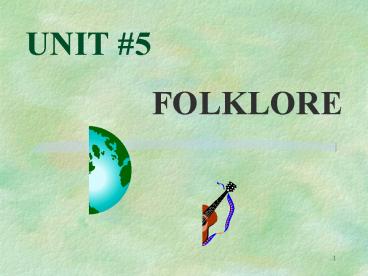FOLKLORE - PowerPoint PPT Presentation
1 / 19
Title:
FOLKLORE
Description:
Continual quest to shape harmonious balance tween physical ... Davy Crockett, Johnny Appleseed, Daniel Boone. John Henry, Pecos Bill, Mike Fink - mythic men ... – PowerPoint PPT presentation
Number of Views:1862
Avg rating:3.0/5.0
Title: FOLKLORE
1
UNIT 5
- FOLKLORE
2
FOLKLORE IN CHILDRENS LIVES
- Roots exist in all societies - from all times.
- Continual quest to shape harmonious balance tween
physical world and our place in it. - Explained world to early people.
- Helps kids understand world today.
- Children search for meaning provides order and
consistency. - Pleasure comes in mastery.
3
FOLKLORE IN CHILDRENS LIVES
- Roots exist in all societies - from all times.
- Continual quest to shape harmonious balance tween
physical world and our place in it. - Explained world to early people.
- Helps kids understand world today.
- Children search for meaning provides order and
consistency. - Pleasure comes in mastery.
4
- Freud
- Fairy tale characters symbolize subconscious
urges of childs emotional development - Bettelheim
- Fairy tales tap unconscious wishes and desires --
repressed emotions. - Allows child to deal with emotional insecurities
- Jung
- Universal nature of the unconscious.
- Similar elements found in myths, legends, folk
tales. - Reappearing themes or archetypes process of
maturing
5
FOLKLORE SOURCES
- North, South Central America
- Europe, Africa Middle East
- Western Asia
- Australia
6
ARCHETYPES IN FOLKLORE
- Images, plot patterns or character types.
- Heros Quest
- Fairy Godmother
- Wicked Witch/Wicked Stepmother
- Benevolent Crone
- Shadow/Evil Underside of Human Nature/Goof Vs.
Evil
7
CRITERIA FOR EVALUATING FOLKLORE
- Authenticity symbols, imagery vocabulary
- Language
- sounds natural (authentic dialogue)
- maintains cultural richness
- structured to quickly involve reader
- Illustrations
- complement and extend narrative
- enrich details
- artistically excellent
8
EVALUATION ANALYSIS
- Synopsis
- Structure -- setting quickly
- stereotyped characters
- Language
- repetition -- events, dialogue
- Illustration
- culture comes through
- text pictures work together
9
TYPES OF FOLKLORE
- Mother Goose Nursery Tales
- Folktales
- Fables
- Mythology
- Hero Tales
- Bible as Literature
10
Mother Goose Nursery Tales
- 1697 -- Charles Perrault -- France
- Characteristics
- rhythm/strong beat
- imaginative use of words ideas
- compact structure
- wit and whimsy of characters -- nonsense/humor
11
Folktales
- One belief -- all emerged from one prehistoric
civilization-- Grimm brothers - Originated in number of places.
- Characteristics
- Narratives -- heroes heroines
- Character stereotyping
- Themes -- value of culture
- Language -- direct, vivid
- Setting -- vague, worlds in themselves
12
Types of Folktales
- Fairy Tales -- magic, wee people, fairy
godmothers - Talking Beast Tales
- Noodlehead Tales
- Cumulative Tales
- Patterns
- Conventions -- Once upon a time. . . .
- Motifs -- symbol, image, device -- stereotyped
characters magic objects/spells/trickery - Themes -- struggle good/evil courage, gallantry,
sacrifice - Variants -- Cinderella
13
Fables
- Brief tale told to point out a moral.
- Explicitly stated moral.
- Taught by allegory -- animals or inanimate
objects represent human traits - Greece -- Aesop slave
- India -- Panchatantra -- Buddha's prior lives
- Hard for younger children to understand
14
Variants of Folktales
- Jack Tales
- Two Sisters
- Beauty and the Beast
- Three Little Pigs
- Cinderella
- Red Riding Hood
- Frog Prince
- Rumpelstiltskin
- Goldilocks the Three Bears
- Baba Yaga
- Snow White the Seven Dwarfs
- Hansel Gretel
- Juan Bobo
15
Mythology
- Stories with roots in primitive folk beliefs.
- Interpret natural events -- to explain and
control natural phenomena - Native American, Aboriginal, Chinese, African,
Aztec Greek/Roman, Norse, African - Sizable part of literary cultural heritage
- Stories relate to each other
- Origin of earth, seasons, fire, water stories of
love, carnage, revenge mystery - Simplest -- pourquoi -- why tales -- explain
customs and natural phenomena
16
Hero Tales
- Recount courageous deeds of mortals as struggle
against each other or against gods and monsters. - King Arthur Robin Hood Trojan War Iliad and
Odyssey - Epics -- sometimes written in verse -- cycle of
tales - Davy Crockett, Johnny Appleseed, Daniel Boone
- John Henry, Pecos Bill, Mike Fink - mythic men
- Exaggerated humor-Paul Bunyan
17
Folksongs Work Songs
- Ballads -- inform persuade foster agreement,
unify people. - Diversion from boring work -- rhythm spirit of
labor - Railroads, tunnels, canals, ships.
- Sing for self-gratification
18
Bible as Literature
- Different -- teach religious doctrine and use to
explore literary content. - Character presented?
- Period Portrayed?
- Lyric poems.
- Contains myths, legends, fables, parables, short
stories, essays, lyrics, epistles, sermons,
orations, proverbs, history, biography, prophecy
and drama.
19
FOLKLORE IN THE CLASSROOM
- Traditional literature foundation for future
literary understanding. - Modern references to folklore are countless.
- Pandoras Box, Midas touch, wolf in sheeps
clothing. - Learn to recognize motifs, themes, story
conventions - Discover recurring patterns, sense of story,
archetypes - Learn values, hopes, fears beliefs of culture
-- bridge of understanding.































